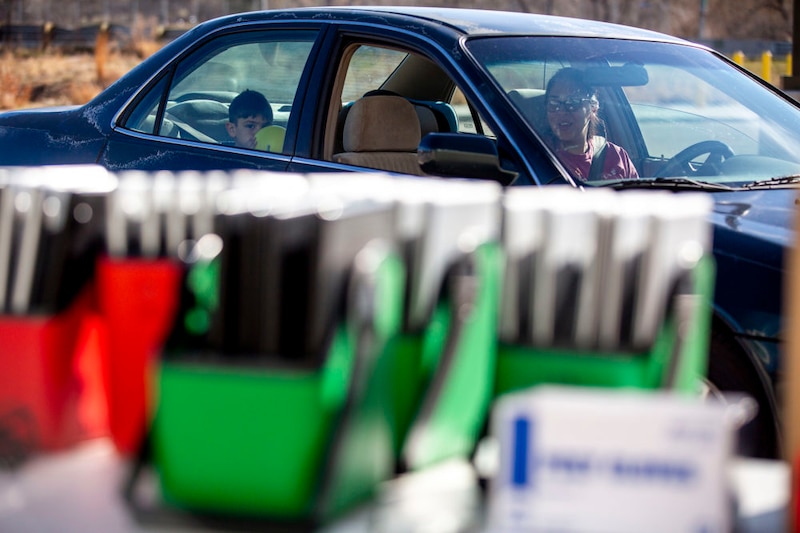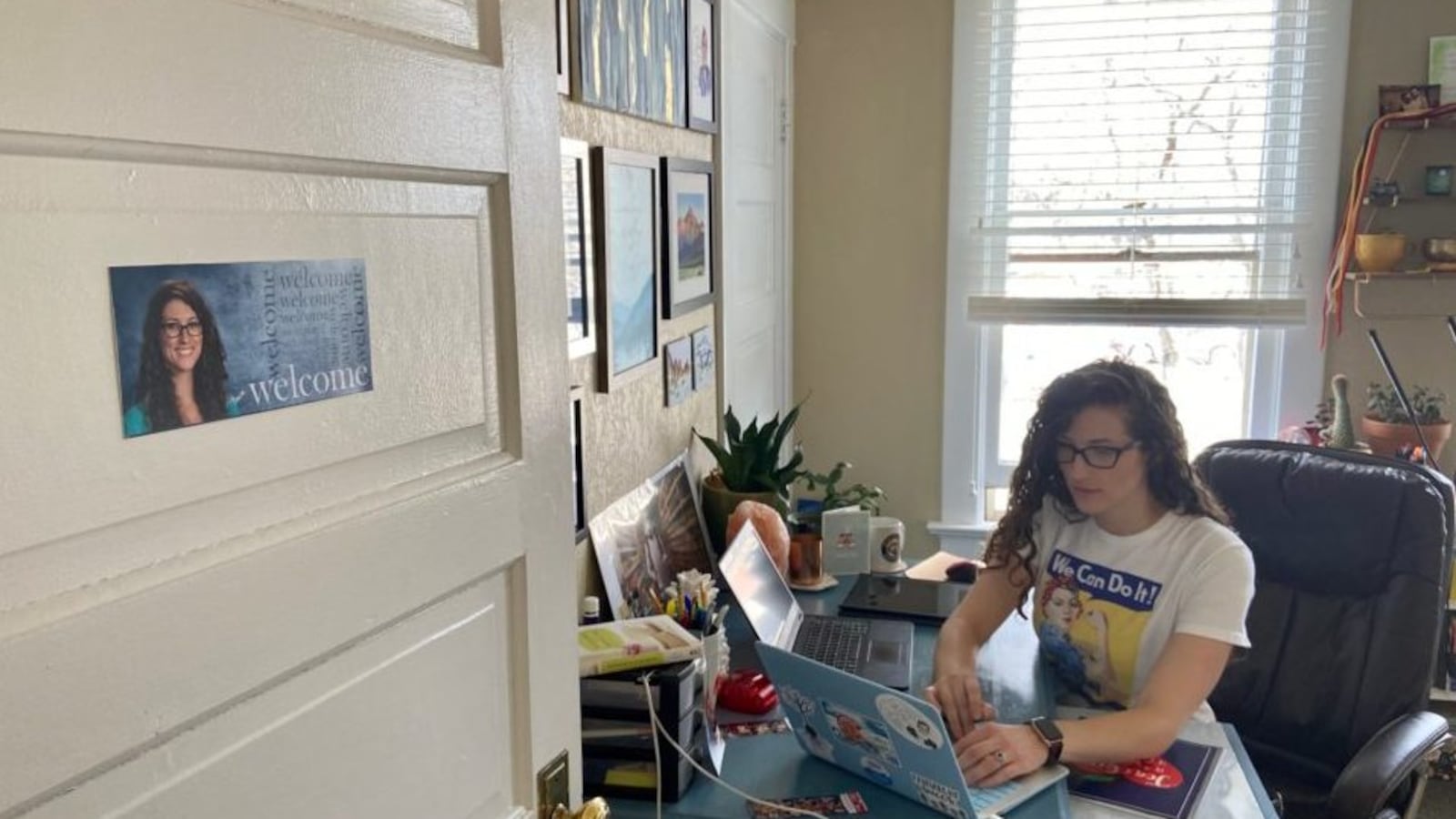Cat Obregon is planning to start next week with a simple assignment: Send a funny meme you found and write a journal entry about how you’re feeling. Are you lonely? Bored? Overwhelmed?
Obregon, who teaches 10th grade English at Denver’s East High School, has two goals for when Colorado’s largest school district transitions to online learning to help slow the spread of the new coronavirus. And like for a lot of teachers, the first goal is not academic.
“The first is that my students feel safe, that they have an opportunity to socialize, and that they get their emotional needs met to the best of my ability,” Obregon said.
Denver Public Schools makes the monumental shift to remote learning Tuesday after a three-week “extended spring break” during which classes were canceled. The district announced Friday that online learning will continue through the end of the school year. Chalkbeat spoke with three school leaders and six teachers about how they’re preparing.
Educators are papering home walls with inspirational posters to make mini classrooms. Older teachers who only recently mastered how to email parents are quickly learning to videoconference. Younger teachers with kids of their own are using them as lesson planning guinea pigs — and wondering how they’re going to balance parenting with teaching.
Like Obregon, the others are most worried about their students’ well-being. At some schools, that fear goes deep. Teachers and principals who work in high-poverty neighborhoods wonder if their students will have enough to eat, if they’ll be able to access the internet, and if they’ll be supervised — or if they’ll be busy supervising younger siblings while their parents work.
“This virus is exposing the opportunity gap in education in ways I don’t think we fully recognized previously,” said Shane Knight, principal of Denver’s Knapp Elementary School.
But he and others are also hopeful that these daunting circumstances will change education for the better, showing teachers new ways to teach and students new ways to learn.
“The biggest opportunity students have is recognizing that it’s OK to fail, it’s OK to not get something right, and to try again,” said teacher Melea Mayen. “Hopefully, this will really give students and families the opportunity to figure out what works for them.”
🔗Not one-size-fits-all
Rather than mandate all teachers do remote learning the same way, Denver Public Schools is allowing schools and educators to choose their own approach. That could mean using district-developed materials or creating their own. Teachers can try broadcasting live lessons, holding virtual office hours, or simply assigning work on Monday that’s due on Friday.
The approximately 93,000 students in Denver Public Schools face a wide variety of circumstances, with nearly two-thirds living in low-income families and a third learning English as a second language. Superintendent Susana Cordova said district leaders kept those disparate circumstances in mind when developing a remote learning strategy.
“We’re putting forth our best effort to make sure all kids keep learning,” Cordova said. “There are kids for whom school is the only opportunity for that, and we want to make sure we’re doing our best for those kids. This is not about accountability. It’s about social justice.”
Most teachers Chalkbeat spoke with are aiming for an approach that combines pre-recorded videos, virtual office hours, and weekly due dates, along with fun social meetups.
Eileen Finnegan teaches social studies at Denver Discovery School. Her middle school students already use the web service Google Classroom to track their assignments and turn in work, but instead of in-class explanations of British philosopher John Locke or the Texas Revolution, Finnegan will pre-record what she’s calling “welcome videos” for each lesson.
Using online photos, maps, and texts, she’ll explain how the United States gained control of Texas. Her students will be responsible for researching and answering questions by Friday. She’ll be online every day from 9 to 10:30 a.m. and again from 12:30 to 3 p.m. to help. With three kids of her own at home, though, Finnegan said she’ll rely on the loud “ping” noise that Google Hangouts makes to alert her when a student has a question.
Monica Hunter is less sure how her days will unfold. Hunter teaches second grade at Green Valley Elementary School. Her students have never used Google Classroom. And she said teaching them to log in to a new website has in the past been an hour-and-a-half ordeal full of forgotten passwords and broken computer chargers.
The one thing she’s nailed down is that she and her fellow second-grade teachers will take turns reading books out loud. The rest, Hunter said, will probably be reviewing key skills her students already learned: how to find details in stories, and how to add and subtract up to 1,000.
“I just can’t imagine teaching new concepts and curriculum to students virtually,” she said.
Despite her trepidation, Hunter said she’s eager to connect with her students again. She keeps thinking about a conversation she had with a little girl the day before school let out.
“I said, ‘How do you feel about this break we’re getting ready to have?’” Hunter recalled. “She said, ‘Not good, because school is the only time I don’t have to worry.’”

🔗Equity issues
Technology is key to remote learning, but not all Denver students have access to it.
Some schools have tablets or laptops for every student. Others, like Knapp Elementary, don’t. More than 95% of Knapp’s 470 students qualify for subsidized school meals, a measure of poverty, and a district survey revealed that only one in five have a computer at home.
School staff hustled last week to distribute devices to students who needed them, said Knight, the principal. But they’re still 189 short. The school is counting on getting some of the 9,000 extra laptops the district ordered last month to fill the gap, Knight said.
In addition to procuring the technology, school staff are having to teach parents how to use it, fielding phone calls and, in some cases, driving to students’ homes to retrieve a laptop from the porch, wipe it down, find a free internet hotspot, and set it back on the porch.
Because of the uneven technology access, Knight said his teachers are having to do double the planning. They are building lessons in Google Classroom but also taking screenshots of their slides to text or email to families whose only device is a smartphone. However, even that plan has flaws: Most families’ phones are pre-paid with limited internet access.
“It’s going to be a lesser experience,” Knight said.
Other educators are worried about students who’ll have to navigate remote learning on their own. Teacher Amy Bergner said she’s already gotten at least one phone call from a parent nearly in tears. The mom has to report to work at a grocery store at 1 p.m. every day. Would it be possible, the mom asked, for her child to complete her lessons in the morning?
Another student is the child of a single mom with four kids who works nights as a truck dispatcher, Bergner said. The daytime is the only time the mom has to sleep.
“I’m worried about the kids who don’t have parents at home to help,” said Bergner, who teaches fourth and fifth grade math and science at Columbian Elementary School, where most students qualify for subsidized meals. “It’s the kids who were already behind, and they’re going to fall further behind. Kids who already had support at home are going to continue to grow.”
Mayen, who teaches history and speech and debate at Northfield High School, is most concerned about the loss of human connection. She said many of her students “shut down” when they don’t understand something. “Me not being there to kneel down next to their desk and tell them to take a deep breath is what makes me most nervous,” she said.
🔗Hope for the future
But in the midst of anxiety and uncertainty, educators are looking for silver linings.
Those could come in the form of innovations. The staff at a small elementary school called Creativity Challenge Community is thinking of ways to keep their school’s traditions alive.
The music teacher is exploring how to host a virtual talent show, and Principal Julia Shepherd is brainstorming ways to carry out the school’s monthly rock ceremony, where students who show kindness, courage, or thinking are gifted a hand-painted rock.
One of her ideas: Mail the rocks to students over the summer.
“Traditions are so important for children,” she said.

Obregon, the high school English teacher, is hopeful that remote learning will better prepare their students for college, where most courses have an online component. They are modeling their lessons after graduate-level classes they’ve taken, while keeping the parts that their students love, including their dramatic read-alouds from books like “The Things They Carried.”
And several educators noted that while remote learning poses steep challenges for providing special services to students who need them, technology also holds promise for students with disabilities and those learning English as a second language.
Instead of students risking embarrassment by raising their hand in class and asking a teacher to repeat something, they can rewind, slow down, or re-watch a recorded lesson. There are apps that can read text aloud or allow students to speak their answers instead of type them.
Whereas only certain teachers had the technology skills to facilitate that type of learning before, the coronavirus pandemic increases the likelihood that in the future, all teachers will. Cordova, the superintendent, said teachers have been open to acquiring new skills.
“We are all learning in this environment,” she said.

